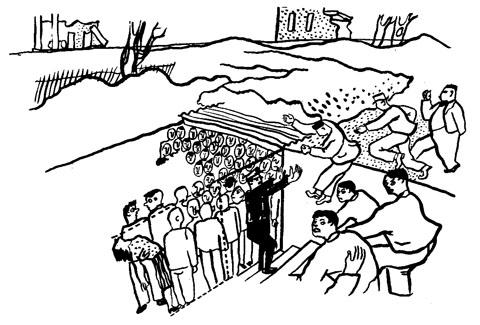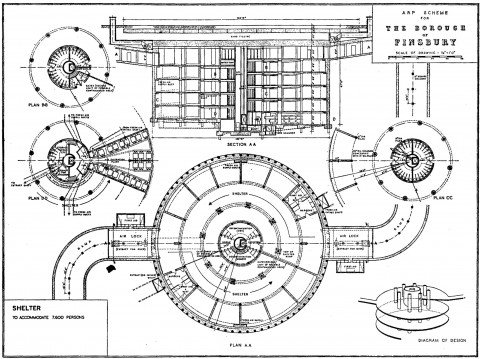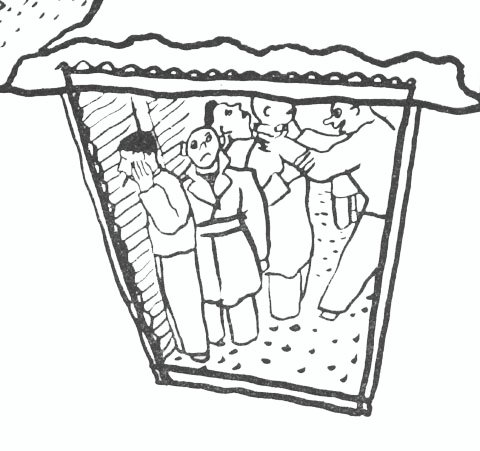
A bomb plunges through the floors of an office building: its denizens look on in astonishment, cower in terror or fall through the holes left in its wake. This is an illustration from a book published in March 1939 by the Tecton group of architects, Planned A.R.P., which described their plan for bomb-proofing the London borough of Finsbury. Tecton helped bring European influences to British architecture, from constructivism to Le Corbusier. In the 1930s, they designed several iconic buildings — literally so, in the case of Finsbury Health Centre, which was used on a 1942 propaganda poster to symbolise the benefits of modern medicine.
I’ll talk a bit more about the plan itself below, but it’s the drawings, and especially the people, which really caught my eye. They are cartoonish, childish even, but still convey horror. They were drawn by Gordon Cullen, later a well-known architect in his own right.

The scything effect of splinters (i.e. shrapnel) on pedestrians.

A crowd crushes into a covered trench shelter in a blind panic, unaware that there is an empty shelter just down the street.

This shelter is full. A woman has fainted. The buildings above ground are already broken shells; another raid appears to be in progress. The shelter warden tries to keep anyone else from coming in.

Shelterers in a basement suffocating to death as the fire above consumes their oxygen. Formations of bombers wheel overhead.

Another basement. The floor of the building above has collapsed into it, crushing the occupants.
As these images suggest, Tecton were very much against the use of both trenches and basements as air raid shelters, both of which which were widely advocated during the Sudeten crisis as offering both quick and cheap protection. Many trenches were indeed dug in September 1938, but were not placed with much regard to the actual population density (especially since the most crowded areas of cities were those with the least amount of open area for trenches). They were also prone to flooding. Basements in turn were the last place you’d want to be in case of gas attack, unless they were fitted with expensive ventilation systems. They also usually had very narrow entrances, leading to the possibility of mobs of panicked people trampling each other to death in their desperation (as had happened at Bishopsgate and Mile End in 1918, and was to happen again at Bethnal Green tube in 1943).

Tecton, of course, had a better solution in mind: purpose-built underground, multistorey shelters. There were to be 15 of these spaced around Finsbury borough. In peacetime they would serve as car parks (for which there was also a growing demand as middle-class car ownership rates started to climb). In wartime, they could hold 7600 people (a second design could hold 12300) spaced out along a ramp spiralling downwards around a service core.

Inside a Tecton shelter. It looks very pleasant — music playing over the Tannoy, couples strolling about, arm-in-arm. But it was meant for serious business. The shelter plan has two spacious entrances for orderly ingress and egress, air locks so that ARP workers could enter and leave without letting poison gas into the shelter, gas decontamination areas for both men and women, air filtration systems, food stores, water supplies, first aid areas. But the Home Office rejected the Tecton plan, and other deep shelter schemes, arguing in the Hailey report that an enemy could disrupt production by forcing the population to take shelter. It favoured dispersal instead, meaning spreading out targets to minimise damage.1 The Tecton scheme was never executed, either at Finsbury or elsewhere.
Joseph Meisel gives the Tecton scheme high marks for cost-effectiveness, but with hindsight it seems to me to be deficient in two ways.2 The first is the lack of beds: it wasn’t anticipated that people would be spending their nights in shelters. Nobody did, much, and it’s something that could have been fixed relatively easily, of course, but it suggests that their calculations for other necessities, like sanitation, might also have been off the mark.
The other shortcoming is the emphasis on gas protection — which wasn’t needed, as it turned out — and the relative neglect of the danger from high explosive bombs. Meisel calls the Tecton shelter an example of a deep shelter, but the top level isn’t very deep at all — there’s only about 30 13.5 feet of sand and concrete between it and the surface. That seems a bit thin: a big bomb could penetrate that. By contrast the system of tunnels proposed by J. B. S. Haldane the previous year was at least 60 feet below the surface, more expensive but certainly safer.3
Of course, using hindsight is unfair, since I have it and Tecton didn’t. Besides, during the war most public shelters had no sanitation beyond the most primitive provisions, at least initially, so Tecton was doing better than most on that score. Their underground shelter certainly offered much better protection than either the flooded trench shelters of 1938 (below) or the flimsy brick surface shelters of 1940.4

Source: Tecton, Planned A.R.P.: Based on the Investigation of Structural Protection Against Air Attack in the Metropolitan Borough of Finsbury (London: Architectural Press, 1939).
![]() This work is licensed under a Creative Commons Attribution-NonCommercial-NoDerivatives 4.0 International License.
Permissions beyond the scope of this license may be available at http://airminded.org/copyright/.
This work is licensed under a Creative Commons Attribution-NonCommercial-NoDerivatives 4.0 International License.
Permissions beyond the scope of this license may be available at http://airminded.org/copyright/.
- Joseph S. Meisel, “Air raid shelter policy and its critics in Britain before the Second World War”, 20th Century British History 5 (1994), 313-4. [↩]
- Ibid., 319. [↩]
- J. B. S. Haldane, A. R. P. (London: Victor Gollancz, 1938). [↩]
- And it was far less silly and far more grounded in reality than the one they note on p. 72:
A suggestion was recently put forward, in all seriousness, for a shelter consisting of a huge steel globe, which would stand in the street, and would simply roll away if it were hit.
. [↩]


30 feet seems quite deep to me, especially as GP bombs didn’t have any great ground-penetrating capability, but I have no idea what the blast effect of (eg.) a 1000kg bomb on top of the shelter would be. I’d guess that the shockwave would be mostly dissipated by the earth, but that’s not supported by any actual evidence :)
Thinking more about this: have you found any damage data that were based on actual tests rather than extrapolated from a previous war? I’m thinking of things like the nuclear bomb effects slide rules that I’ve seen in civil defence books – I vaguely recall someone has even built a webpage that lets you enter details and survey the destruction…
As for cost-effective, that shelter looks huge – I can see the one-off capital outlay needed for one of those being off-putting to government compared with the slow trickle needed to dig trenches and reinforce cellars, but again this is just musing. Of course for cost-effectiveness tube stations were very hard to beat.
Actually, I’m not sure where that figure of 30′ came from! Looking at it again, the roof is only 13.5′ (7 feet of earth, 6.5 of — presumably — reinforced concrete) thick. Below that is the entrance level, which is 8.5′ high. I was assuming that would be empty (not sure why, actually) but still that offers no extra protection. And then after that the floor of the ramp is only 0.5′ thick, which seems very thin indeed! Still, the roof was layered (earth, concrete, earth, concrete), which accorded with the latest thinking on best protection. And they did provide thicker walls on the sides at the top, to give extra protection against glancing blows.
No, I haven’t seen anything about experimental data on blast damage etc, that I can recall. (There is some stuff on gas protection from civilian scientists.) You have to wonder why — it seems like an obvious thing to do. But operational research was still in its infancy;and the RAF didn’t set up its first bombing development unit until September 1939!
Pingback: Airminded · Straight to the pool room — II